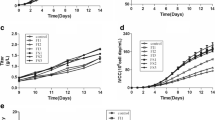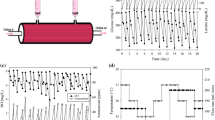Abstract
Production of monoclonal antibody against hepatitis B surface antigen was carried out by perfusion culture coupled with a selective removal system for ammonium ion. The removal system is composed of three sub-systems namely, cell separation by cross-flow ceramic filter, dialysis by hollow fiber module and ion-exchange by zeolite A-3 packed bed column. The ammonium ion concentration in the culture broth was effectively maintained below the inhibitory level, and the viable cell density reached 2.5×107 cells ml−1 which was three times that of conventional perfusion cultures. The monoclonal antibody accumulated to a concentration as high as 26.3×105 mIU−1. This is already almost half of the amount producedin vivo. The numerical investigation of the ammonium ion removal system showed the possibility to improve much more the performance of this perfusion cultivation system.
Similar content being viewed by others
References
Crank, J (1956) The Mathernatics of Diffusion. Oxford, Clarendon Press.
Hasell T., Gleave S and Butler N (1991). Growth inhibition in animal cell culture, The effect of lactate and ammonia. App. Biochem. Biotechnol. 30: 29–41.
Harigae M, Matsumura M and Kataoka H (1993) Kinetic study on HBs-MAb production in continuous cultivation. J. Biotech. 24: 227–235.
Martinelle K and Häggström L (1994) In: “Animal Cell Technology: Products of Today. Prospects for Tomorrow” Spier RE Griffiths JB and Berthold. W (eds.) pp. 158–161, Butterworth-Heinemann.
Matsumura M Shimada, M Arii T and Kataoka H (1991) Adaptation of hybridoma cells to higher ammonia concentration. Cytotechnology 7: 103–112.
McQueen A and Bailey E (1990) Effect of ammonium ion and extracellular pH on hybridoma cell metabolism and antibody production. Biotechnol. Bioeng. 35: 1065–1077.
Nayve Jr, Fidel Rey P, Motoki M, Matsumura M and Kataoka H (1991) Selective removal of ammonia from animal cell culture broth. Cytotechnology 6: 121–130.
Noda M, Kawada H, Matsushita T and Funatsu K (1989) Proceedings of the 22nd Autumn Meeting of Japan Chemical Engineering, pp. 471.
Ozturk SS, Riley MR and Palsson BO (1992) Effects of ammonia and lactate on hybridoma growth, metabolism and antibody production. Biotechnol. Bioeng. 39: 418–431.
Reuveny S, Velez D, Macmillan JD and Miller L (1986) Factors affecting cell growth and monoclonal antibody production in stirred reactors. J. Immunol. methods. 86: 53–59.
Ryll T, Valley U and Wagner R (1994) Biochemistry of growth inhibition by ammonium ions in mammalian cells. Biotechnol. Bioeng. In press.
Saito H, Yasuda J and Korosawa M (1982) Standardization of the national reference anti-HBs, immunoglobulin by radioimmunoassay. Jpn. J. Med. Sci. Biol. 35: 143–151.
Sherman JP (1978) Ion-exchange separation with molecular sieve zeolites. Am. Inst. Chem. Engr. Symp. Series 74: 98–116.
Thorens B and Vassali P (1986) Chloroqunie and ammonium chloride prevent terminal glycosylation of immunoglobulins in plasma cells without affecting secretion. Nature 321: 618–620.
Author information
Authors and Affiliations
Rights and permissions
About this article
Cite this article
Matsumura, M., Nayve, F.R.P. Effects of ammonium ion removal on growth and MAb production of hybridoma cells. Cytotechnology 18, 35–50 (1995). https://doi.org/10.1007/BF00744318
Issue Date:
DOI: https://doi.org/10.1007/BF00744318




